A surprisingly strong G3-class geomagnetic storm erupted on Aug. 15th when a CME hit Earth's magnetic field. Two nights later, as the storm was subsiding, midnight sky watchers in North America witnessed a rare and beautiful form of aurora--a "proton arc." Paul Zizka photographed the phenomenon on Aug. 17th from Banff, Alberta:
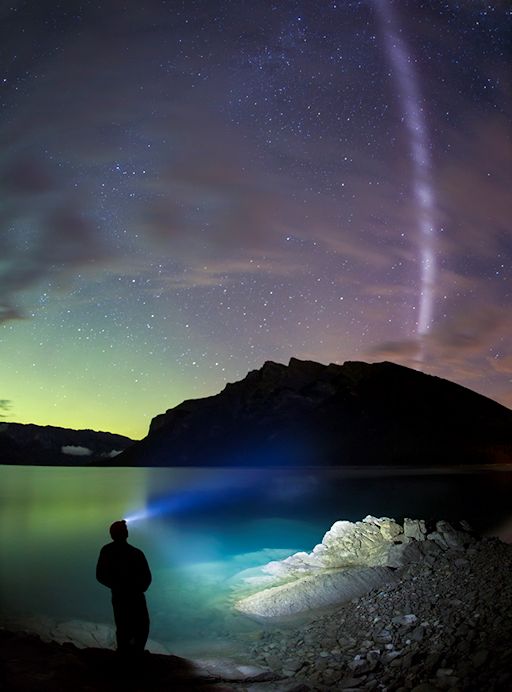
photo Paul Zizka
"It was incredible," says Zizka. "The whitish pillar remained nearly stationary for over 30 minutes--enough time for a self-portrait."
In Val Marie, Saskatchewan, photographer Sherri Grant saw a purple proton arccutting across the Milky Way. And in Oroville, Washington, at the Table Mountain Star Party, campers witnessed at least two more arcs.
Ordinary auroras are caused by electrons, which rain down on Earth's atmosphere from above. Atoms of oxygen and nitrogen, excited by the pitter-patter of electrons, form dynamic curtains of light. Protons have a different effect. For reasons not fully understood, protons normally trapped in our planet's ring current sometimes rain down on Earth's atmosphere during geomagnetic storms. En route, they excite a type of plasma wave called "EMIC"--short for electromagnetic ion cyclotron waves. The result is not a curtain, but rather a tight arc of light as shown above.
Many of the photographers who witnessed proton arcs on Aug. 17th have been observing auroras for years, yet they had never seen this phenomenon before.
Bron:http://www.spaceweather.com/ | Gewijzigd: 1 februari 2017, 11:41 uur, door Joyce.s
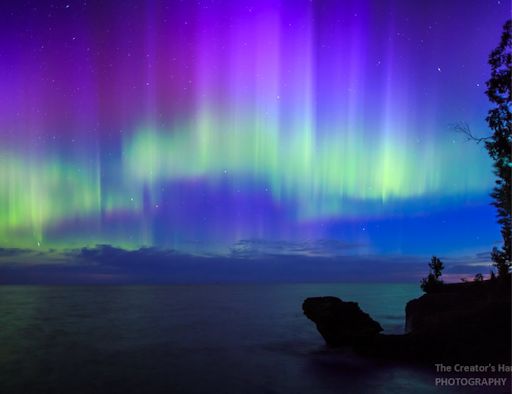
"I was out most of the night enjoying and photographing the Northern Lights," says Nelson. "The display started to fade around 5:30 a.m. and then, just like in a fireworks display, the whole sky suddenly lit up. It was the Grand Finale! I captured the moment in the photo, above."
How can such a display occur while solar activity is so low? The answer has to do with the interplanetary magnetic field (IMF). On Sept. 7th, the IMF tilted south, opening a crack in Earth's magnetosphere. Solar wind (which exists even during times of quiet) poured in to fuel the auroras.
High-latitude sky watchers should remain alert for more on Sept. 10th. NOAA forecasters estimate a 70% chance of geomagnetic storms as the solar wind continues to blow.
Bron: http://www.spaceweather.com/
So far, September has been a great month for auroras. A series of solar wind streams, mixed with one or two minor CMEs, has buffeted Earth's magnetic field almost non-stop for the past two weeks. The resulting G1- to G3-class geomagnetic storms have caused displays like this:

Photo Minoru Yoneto
Minoru Yoneto took the picture on September 11th from Queenstown, New Zealand. "A big stream of solar wind gave us four lovely colors of Southern Lights," he says.
One reason for the recent spate of auroras is the coming change of seasons. For reasons that are not fully understood, auroras love equinoxes. At this time of year even gentle gusts of solar wind can spark a nice display of Northern or Southern Lights
Two gusts are on the way. NOAA forecasters expect streams of solar wind to reach Earth early on Sept. 14th and later on Sept. 15th, sparking renewed displays of high-latitude auroras. Monitor the realtime photo gallery for updates.
Bron:http://www.spaceweather.com/ | Gewijzigd: 1 februari 2017, 11:42 uur, door Joyce.s
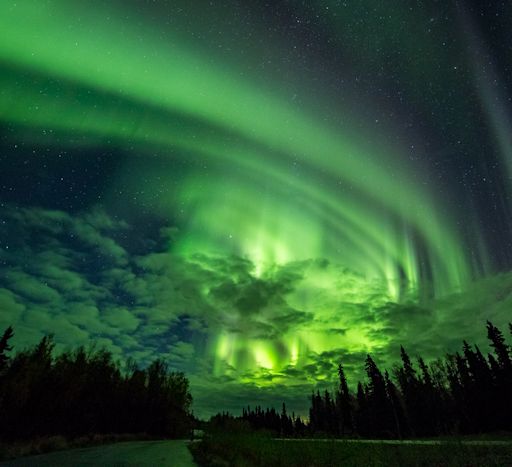
photo Marketa S Murray
The display was caused by a stream of solar wind, which is buffeting Earth's magnetic field this week. It is just the latest episode in a month-long run of great auroras around the Arctic Circle.
One reason for the recent spate of auroras is the coming change of seasons. For reasons that are not fully understood, auroras love equinoxes. At this time of year even gentle gusts of solar wind can spark a nice display of Northern or Southern Lights.
NOAA forecasters estimate a 40% chance of more geomagnetic storms and auroras on Sept. 16th as the solar wind continues to blow.
Bron: http://www.spaceweather.com/ | Gewijzigd: 1 februari 2017, 11:42 uur, door Joyce.s
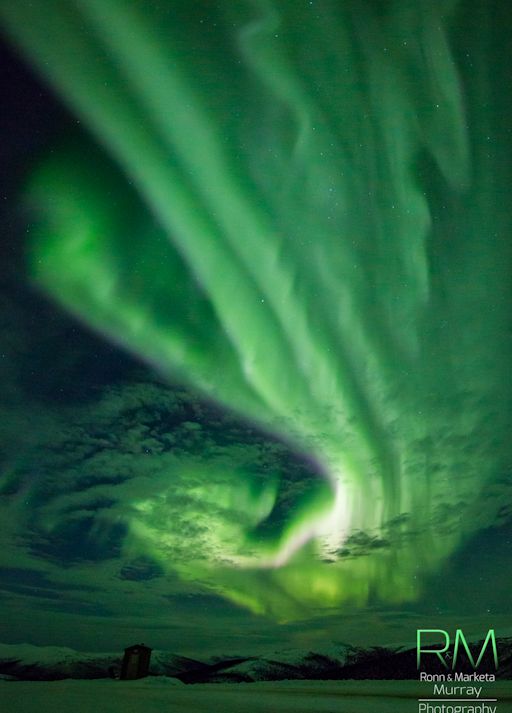
"There were clouds around Fairbanks, so we drove 100 miles to find a clearer sky," says Murray. "The auroras were awesome and our clients were very happy. "
For the rest of this week, and over the weekend, Earth's environment in space will be dominated by this stream of solar wind. As a result, more Arctic auroras are in the offing. Stay tuned.
Bron:http://www.spaceweather.com/
LONG RANGE AURORA FORECAST
On Oct. 7th and 8th, a high-speed stream of solar wind hit Earth's magnetic field, sparking strong geomagnetic storms and auroras. On Nov. 2nd - 5th, it could happen again. The same solar wind stream that caused the October storms is set to return during the first week of November. It is flowing from this hole in the sun's atmosphere: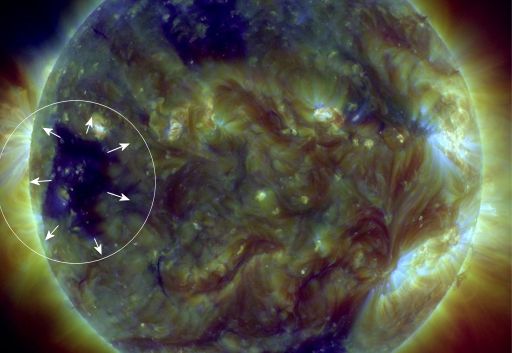
Image credit: NASA/Solar Dynamics Observatory. Oct. 28, 2015.
The dark circled region, called a "coronal hole," is where the sun's magnetic field has opened up, allowing solar wind to escape. The last time this particular coronal hole turned toward Earth, in early October, it lashed our planet's magnetic field with an 800 km/s solar wind stream. Now it is turning toward Earth again. Aurora fans, mark your calendar for the first week of November.
Bron: http://www.spaceweather.com/
CME MISSES EARTH, AURORAS APPEAR ANYWAY:
A CME expected to deliver a glancing blow to Earth's magnetic field on Oct. 30th did not. It missed. Sky watchers around the Arctic Circle saw auroras anyway. Anne Birgitte Fyhn sends this picture from Kvaløya island, Tromsø, Norway: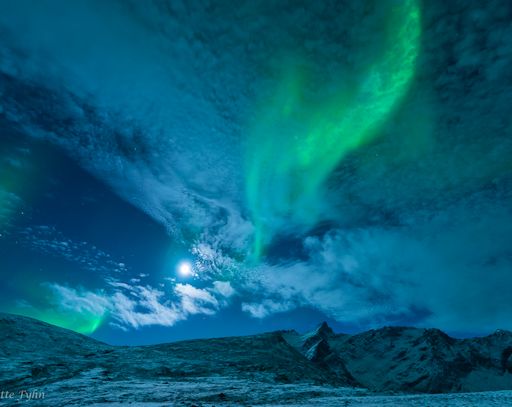
"The partly cloudy weather made this evening extra exciting," says Fyhn. "I was lucky to witness a beautiful show where the auroras and the appearing clouds competed covering the stars."
Tromsø is just above the Arctic Circle where even gentle gusts of solar wind can spark Northern Lights--no CME required. More lights could be in the offing. NOAA forecasters say Earth is going to cross a fold in the heliospheric current sheet on Halloween (Oct. 31st), a crossing which could scare up some spooky auroras.
Bron: http://www.spaceweather.com/
Arriving almost a full day earlier than expected, a CME struck Earth's magnetic field on Nov. 6th at 18:00 UT. At first, the impact had little effect. As Earth moved deeper into the CME's wake, however, aG2-class geomagnetic storm broke out. Nikolay Alfertiev photographed the auroras over Russia's Kola peninsula:
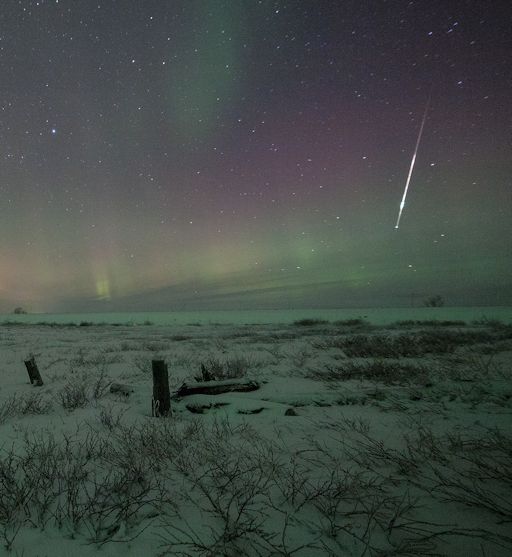
photo Nikolay Alfertiev
"A Taurid fireball cut through the auroras as I took this picture before sunrise on Nov. 7th," says Alfertiev.
NOAA forecasters estimate a 50% to 60% chance of continued geomagnetic storms on Nov. 7-8. Auroras could descend to northern-tier US states such as Washington, Michigan, and Maine
Bron: http://www.spaceweather.com/

http://polaris.nipr.ac.jp/~acaurora/aurora/Tromso/latest.jpg
| Gewijzigd: 1 februari 2017, 11:43 uur, door Joyce.s
A CME hit Earth's magnetic field on Friday, Nov. 6th, setting the stage for a weekend display of aurora borealis. "The little town of Sunburst, Montana, seemed like an appropriate place to wait for Friday's burst of solar plasma to arrive," says photographer John Ashley, " so that is where I set up my camera." He calls this snapshot Sunburst Auroras:
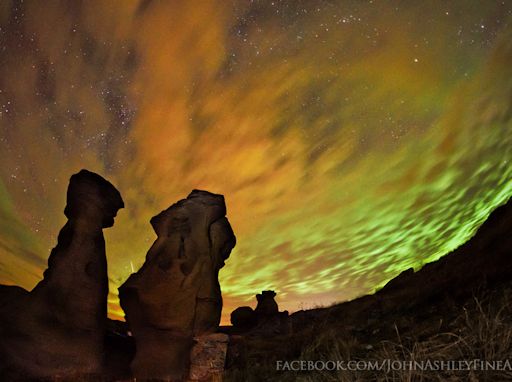
"The cap rock and hoodoo figures were a polite and captive audience watching the light show, and the only grumblings I heard about clouds was from the photographer," continues Ashley. "Green was the only aurora color detected, while light trespass from Sunburst colored some of the lower clouds orange. A handful of meteors also joined in."
More auroras are in the offing. NOAA forecasters estimate a 45% chance of polar geomagnetic storms on Nov. 9th as a negative-polarity stream of solar wind buffet's Earth's magnetic field. Northern sky watchers should be alert for lights in the sky after nightfall.
Bron:http://www.spaceweather.com/
CME ARRIVES, SPARKS AURORAS:
A coronal mass ejection (CME) swept past Earth during the late hours of Nov. 18th, and when the CME's flank hit Earth's magnetic field it sparked a bright display of Arctic auroras. Runólfur Hauksson witnessed the outburst over Hornafjörður, Iceland: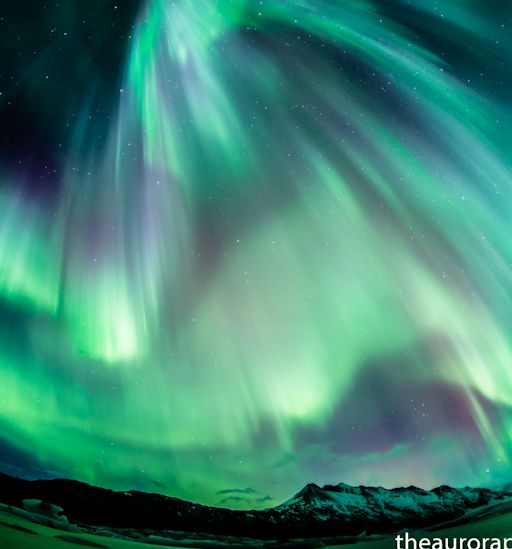
photo Runólfur Hauksson
According to Hauksson, "they were nice and bright" -- a comment which both describes the auroras and provides an example of Icelandic understatement.
The auroras are subsiding now, but they could flare up again as Earth moves through the turbulent wake of the CME. NOAA forecasters estimate a 55% chance of renewed geomagnetic storms on Nov. 19th.
Bron:http://www.spaceweather.com/ | Gewijzigd: 1 februari 2017, 11:43 uur, door Joyce.s
Southern lights
It doen't feel like aurora season in New Zealand. "Summer is coming and it is getting warm," explains southern photographer Taichi Nakamura. "Darker night hours are rapidly shrinking with only 5 hours at most between twilights." Nevertheless, during that narrow window of balmy darkness on Dec. 1, the auroras appeared: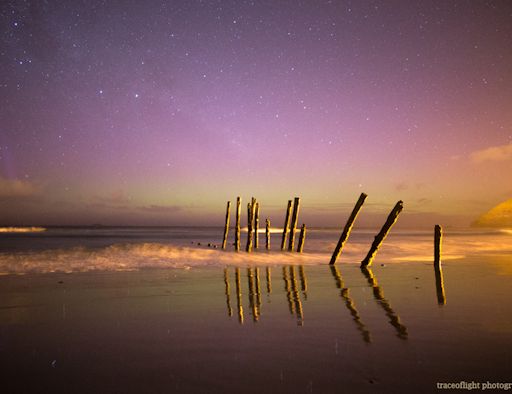
"The subtle glow of Southern Lights appeared at midnight during super low tide at St. Clair beach in Dunedin," says Nakamura. "The iconic pier at the beach got washed away by Mother Nature a while ago. What remains still stands strong."
The display was caused by a solar wind stream, which hit Earth's magnetic field on Nov. 30th. The impact caused a G1-class geomagnetic storm and auroras around both poles. NOAA forecasters estimate a waning 25% chance of polar geomagnetic storms on Dec. 2nd as Earth slowly exits the solar wind stream.
http://www.spaceweather.com/
Vandaag 40% kans op aurora borealis, morgen 55% kans:
Dit komt doordat een zonnewind arriveert van het coronale gat dat nu in lijn met de aarde staat:
So stay tuned voor mooie nieuwe foto's in de aurora galerij
Bron: http://www.spaceweather.com/
ARCTIC RECYCLING BINS:
A co-rotating interaction region (CIR) hit Earth's magnetic field on Dec. 10th, and a high-speed stream of solar wind arrived soon thereafter. The double blow sparked bright auroras around the Arctic Circle. Oliver Wright photographed the display from Abisko, Sweden: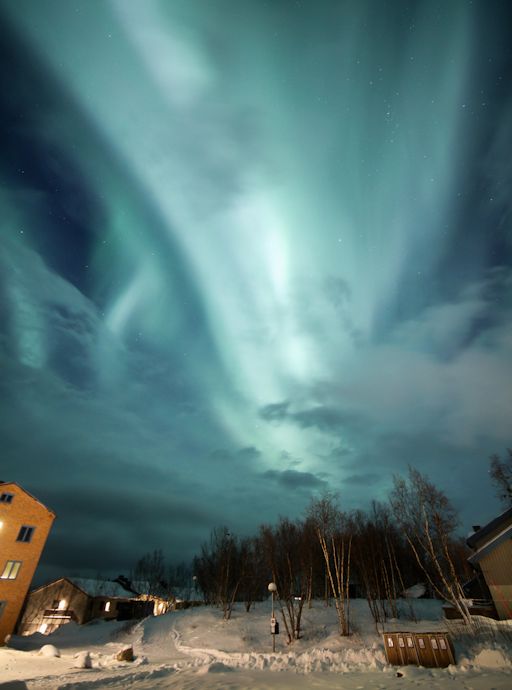
Photo . Oliver Wright
"I was setting up to guide a Lights Over Lapland aurora photo tour," says Wright. "I had good expectations because of the co-rotating interaction region I'd seen forecast on Spaceweather.com. As I was waiting for the guests to arrive, I just popped my head out of the door to see a huge aurora developing. We can't always pick our compositions, but I reckon I might have got one of the best shots of the hotel's recycling bins in history!"
Arctic sky watchers should be alert for more auroras in the nights ahead. NOAA forecasters estimate a 45% chance of polar magnetic storms on Dec. 11 as the solar wind continues to blow.
Bron:http://www.spaceweather.com/ | Gewijzigd: 1 februari 2017, 11:44 uur, door Joyce.s
Geomagnetische storm:
A G2-class geomagnetic storm is in progress on Dec. 20th as Earth moves through the wake of a CME that struck our planet's magnetic field yesterday. Ayumi Y. Bakken photographed the display from Fairbanks, Alaska:
photo Ayumi Y. Bakken
What a wonderful night!" says Bakken. "The aurora was dancing all night starting around 7pm. Even my car reflected the green light."
NOAA forecasters estimate a 50% chance of continued storming tonight, waning to 15% on Dec. 22nd as CME effects subside. High-latitude sky watchers should be alert for auroras.
Bron:http://www.spaceweather.com/ | Gewijzigd: 1 februari 2017, 11:44 uur, door Joyce.s
Winter nights are supposed to be long and dark. This week they have only been long. Auroras around the Arctic Circle have wiped out the darkness with displays like this:
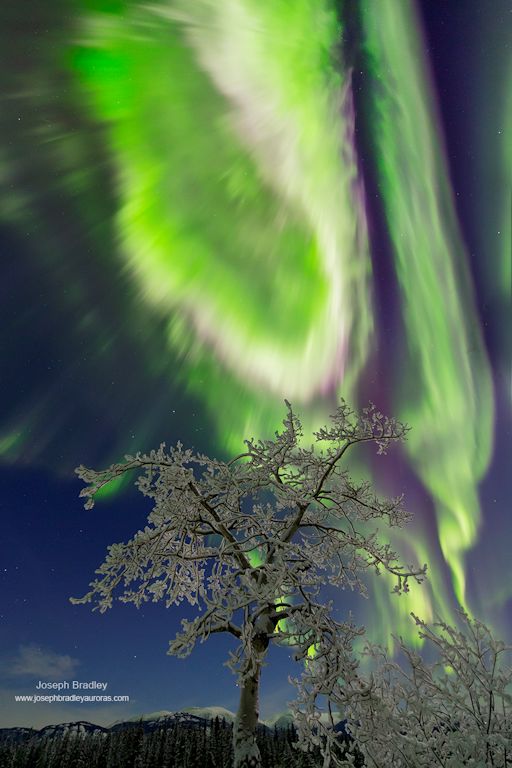
"It was a beautiful evening in the Yukon," says Joseph Bradley, who took the picture on Dec. 20th. "The lights came out early and--WOW--what an amazing show. It had me running all over the place. Fellow photographer Jono and I had a great 4 hour run!!"
The lights Bradley saw were ignited by a CME strike on Saturday, Dec. 19th. The impact caused intermittant G1 and G2-class geomagnetic storms for nearly two days. Those storms are subsiding now, possibly opening a window into winter darkness. NOAA says the chance of polar geomagnetic storms on Dec. 22nd is no more than 20%
Bron: http://www.spaceweather.com/

 Aurora galerij
Aurora galerij





